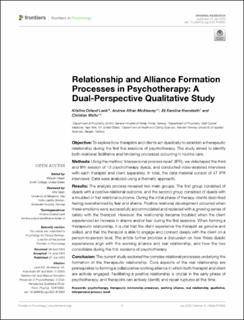| dc.contributor.author | Lavik, Kristina O. | |
| dc.contributor.author | McAleavey, Andrew | |
| dc.contributor.author | Kvendseth, Eli Karoline | |
| dc.contributor.author | Moltu, Christian | |
| dc.date.accessioned | 2023-02-16T08:18:38Z | |
| dc.date.available | 2023-02-16T08:18:38Z | |
| dc.date.created | 2022-08-18T12:58:11Z | |
| dc.date.issued | 2022 | |
| dc.identifier.citation | Frontiers in Psychology. 2022, 13 . | en_US |
| dc.identifier.issn | 1664-1078 | |
| dc.identifier.uri | https://hdl.handle.net/11250/3051309 | |
| dc.description.abstract | Objective: To explore how therapists and clients act dyadically to establish a therapeutic relationship during the first five sessions of psychotherapy. The study aimed to identify both relational facilitative and hindering processes occurring in routine care. Methods: Using the method ‘interpersonal process recall’ (IPR), we videotaped the third and fifth session of 12 psychotherapy dyads, and conducted video-assisted interviews with each therapist and client separately. In total, the data material consist of 47 IPR interviews. Data were analyzed using a thematic approach. Results: The analysis process revealed two main groups. The first group consisted of dyads with a positive relational outcome, and the second group consisted of dyads with a troubled or frail relational outcome. During the initial phase of therapy, clients described feeling overwhelmed by fear and shame. Positive relational development occurred when these emotions were successfully accommodated and replaced with a growing sense of safety with the therapist. However, the relationship became troubled when the client experienced an increase in shame and/or fear during the first sessions. When forming a therapeutic relationship, it is vital that the client experience the therapist as genuine and skilled, and that the therapist is able to engage and connect deeply with the client on a person-to-person level. The article further provides a discussion on how these dyadic experiences align with the working alliance and real relationship, and how the two consolidate during the first sessions of psychotherapy. Conclusion: The current study explored the complex relational processes underlying the formation of the therapeutic relationship. Core aspects of the real relationship are prerequisites to forming a collaborative working alliance in which both therapist and client are actively engaged. Facilitating a positive relationship is crucial in the early phase of psychotherapy, and therapists can actively identify and repair ruptures at this time. | en_US |
| dc.language.iso | eng | en_US |
| dc.publisher | Frontiers Media S.A. | en_US |
| dc.rights | Navngivelse 4.0 Internasjonal | * |
| dc.rights.uri | http://creativecommons.org/licenses/by/4.0/deed.no | * |
| dc.title | Relationship and Alliance Formation Processes in Psychotherapy: A Dual-Perspective Qualitative Study | en_US |
| dc.type | Peer reviewed | en_US |
| dc.type | Journal article | en_US |
| dc.description.version | publishedVersion | en_US |
| dc.rights.holder | Copyright © 2022 Lavik, McAleavey, Kvendseth and Moltu | en_US |
| dc.source.pagenumber | 17 | en_US |
| dc.source.volume | 13 | en_US |
| dc.source.journal | Frontiers in Psychology | en_US |
| dc.identifier.doi | 10.3389/fpsyg.2022.915932 | |
| dc.identifier.cristin | 2044179 | |
| cristin.ispublished | true | |
| cristin.fulltext | original | |
| cristin.qualitycode | 1 | |

